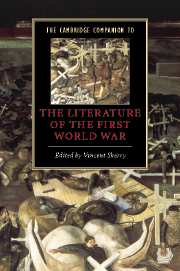Book contents
- Frontmatter
- Introduction
- Part I The Great War in British literary culture
- Part II The world war: Pan-European views, transatlantic prospects
- Part III Postwar engagements
- 10 Myths, memories, and monuments: reimagining the Great War
- 11 Interpreting the war
- 12 The Great War in twentieth-century cinema
- Guide to Further Reading
- Index
- Series List
10 - Myths, memories, and monuments: reimagining the Great War
from Part III - Postwar engagements
Published online by Cambridge University Press: 28 May 2006
- Frontmatter
- Introduction
- Part I The Great War in British literary culture
- Part II The world war: Pan-European views, transatlantic prospects
- Part III Postwar engagements
- 10 Myths, memories, and monuments: reimagining the Great War
- 11 Interpreting the war
- 12 The Great War in twentieth-century cinema
- Guide to Further Reading
- Index
- Series List
Summary
When considering the legacy of the Great War, one is inevitably drawn to consider why that war is so frequently reimagined by modern writers. What is to be gained, after nearly a century, from resurrecting the stories embedded in the work of Owen, Sassoon, and Graves? Why does this war haunt the English cultural imagination? And why, specifically, is it the story of the infantry officer on the Western Front that is told and retold by writers as diverse as Stuart Cloete, Susan Hill, and Jennifer Johnston, by Joan Littlewood's Theatre Workshop and the writers of Blackadder Goes Forth, and, in the 1990s, by Sebastian Faulks, Pat Barker, and Kate Atkinson?
There are, of course, exceptions to and variations on the theme of subaltern disillusion, some of which are included in the work of writers named above. And there are alternative perspectives – those of women, of the colonial regiments, of the working classes, and of the other fronts on which the war was fought. Even in the 1920s and 1930s, when the rash of memoirs emerged that seemed to solidify the subaltern’s story, its universality was questioned. Douglas Jerrold, for instance, objected to what he called the “anti-war” stance as unrepresentative of the young men who experienced the war positively, in terms of adventures and action hitherto unknown. The narrative of bitter disillusionment, according to him, was not the only story.
- Type
- Chapter
- Information
- The Cambridge Companion to the Literature of the First World War , pp. 245 - 260Publisher: Cambridge University PressPrint publication year: 2005
- 2
- Cited by



